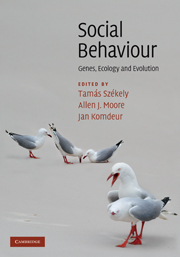Book contents
- Frontmatter
- Contents
- List of contributors
- Introduction: The uphill climb of sociobiology: towards a new synthesis
- Profile: Undiminished passion
- Part I Foundations
- 1 Nature–nurture interactions
- Profile: Social evolution, sexual intrigue and serendipity
- 2 The quantitative genetics of social behaviour
- Profile: Mating systems: integrating sexual conflict and ecology
- 3 Social behaviour and bird song from a neural and endocrine perspective
- Profile: In love with Ropalidia marginata: 34 years, and still going strong
- 4 Evolutionary game theory
- Profile: The huddler's dilemma: a cold shoulder or a warm inner glow
- 5 Recent advances in comparative methods
- Profile: Multi-component signals in ant communication
- 6 Social evolution theory: a review of methods and approaches
- Profile: What's wrong with this picture?
- Part II Themes
- Part III Implications
- Species index
- Subject index
- References
Profile: Social evolution, sexual intrigue and serendipity
Published online by Cambridge University Press: 05 June 2012
- Frontmatter
- Contents
- List of contributors
- Introduction: The uphill climb of sociobiology: towards a new synthesis
- Profile: Undiminished passion
- Part I Foundations
- 1 Nature–nurture interactions
- Profile: Social evolution, sexual intrigue and serendipity
- 2 The quantitative genetics of social behaviour
- Profile: Mating systems: integrating sexual conflict and ecology
- 3 Social behaviour and bird song from a neural and endocrine perspective
- Profile: In love with Ropalidia marginata: 34 years, and still going strong
- 4 Evolutionary game theory
- Profile: The huddler's dilemma: a cold shoulder or a warm inner glow
- 5 Recent advances in comparative methods
- Profile: Multi-component signals in ant communication
- 6 Social evolution theory: a review of methods and approaches
- Profile: What's wrong with this picture?
- Part II Themes
- Part III Implications
- Species index
- Subject index
- References
Summary
Like many aspects of science, my interest in social evolution came about at least in part by accident. My early training was in population and community ecology, on plants and rodents living rather asocial lives. Although I had read much of Peter Klopfer's 1973 book Behavioral Aspects of Ecology, my own evolutionary interests were primarily focused on life-history evolution. The first turning point came when Mike Cullen, formerly from Oxford but recently appointed to a chair in the Monash Zoology Department where I was studying for my doctorate, popped into the office I shared with Dick Braithwaite, another aficionado of rodent population biology, and dropped off what I am fairly sure was the first copy in Australia of the landmark 1978 textbook by Krebs and Davies. This book, with its excitement and clarity of thought, should remain compulsory reading for everybody, despite its subsequent eclipse by later editions.
There is no doubt that the next greatest influence was the classic book and series of articles produced in the early 1980s by Tim Clutton-Brock, Steve Albon and Fiona Guinness on the ecology of red deer Cervus elaphus (Clutton-Brock et al. 1983). Their focus on lifetime estimates of fitness in free-living animals seemed to me to be the work I would like to do. I also felt that I had found the perfect study animal. The commonest marsupials in nearby forests were antechinuses, small shrew-like animals with strange sex lives.
- Type
- Chapter
- Information
- Social BehaviourGenes, Ecology and Evolution, pp. 26 - 28Publisher: Cambridge University PressPrint publication year: 2010



